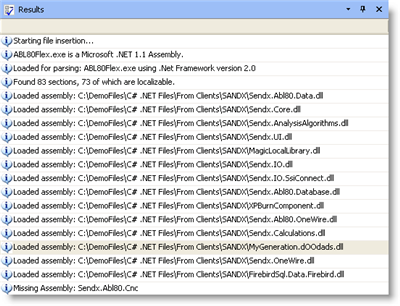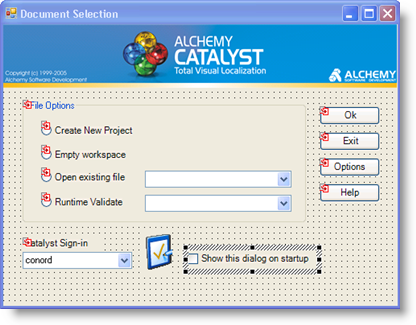![]()
How to localize .NET applications
|
|
How to localize .NET applications |
|
Alchemy CATALYST processes compiled binary .NET applications and builds optimised or unoptimised language assemblies automatically. Since the binary application contains more information than .resx files, winforms are displayed more visually and inheritance information is available to both the translator and engineer during the localization process. This makes it a faster and more efficient way of localizing .NET applications.
|
|
It's very important to set the Target Language in a Project TTK when working with .NET application files as Alchemy CATALYST uses the Target Language to generate the correct RFC 1766 localised filename for translated .NET applications. |
 Inserting .NET Applications into Project TTKs
Inserting .NET Applications into Project TTKs
Use Insert Files to add a .NET application to a Project Your project is where you manage and organize all the files that are to be localised. TTK file. During insertion, Alchemy CATALYST will locate and cache all dependant assemblies for this application. The Results Toolbar will display helpful progress information to assist localization engineers when working on complex .NET applications.

The Results Toolbar will display the names of dependant assemblies and confirm that they have been cached in the Project TTK. It will also display the number of resource segments in the application and the number of localizable segments.
If a dependent assembly is not available during file insertion, a warning message will be displayed in the Results Toolbar. Use this information to locate and install these dependant assemblies on your desktop. Then re-insert the .NET application to allow Alchemy CATALYST cache these assemblies within the Project TTK.
If these dependant assemblies are not available, Alchemy CATALYST will still process the .NET application, however, some winforms may not be rendered in a true 100% WYSIWYG manner.
Generally speaking, it's best practice to have all dependant assemblies available on your desktop when inserting .NET applications. This helps Alchemy CATALYST detect all inheritance information which is useful during localization.
|
|
Translators Professional linguist specializes in the localization of web site, online help systems and software applications. working on Project TTK containing .NET applications do not need dependant assemblies available to them on their desktop. This is because Alchemy CATALYST will have a cached version of these stored within the Project TTK. These dependant assemblies will then be installed into the General Assembly Cache(GAC Global Assembly Cache : This is maintained by the .NET framework and stores reference information for all signed assemblies on a host PC. It is used by Alchemy CATALYST to resolve any inter-dependancy that may exist between .NET applications.) on their machines allowing them to work in a highly visual mode during translation. |

The Dialog Editor is used to translate, engineer and test .winforms. Alchemy CATALYST locates all dependant assemblies and caches them in the Project TTK to ensure that winforms can be visually displayed during localization.
The Menu Editor is used to translate, engineer and test .NET menus. Since .NET applications do not contain the hierarchical structure of menus, this editor displays the text in a flat list only.
Use the String Editor to translate, engineer and test application files that contain Strings.
 To Build a localized .NET application
To Build a localized .NET application
Use Extract File to build localized .NET applications. Alchemy CATALYST will create all necessary language assemblies and create the relevant folder structure to save these in.
 Creating optimised language assemblies
Creating optimised language assemblies
To create optimised assembly files, go to General Options- .NET Framework and select Extract only modified resources to satellite assemblies. Once this option is switched on, only changes are stored in language assembly files.